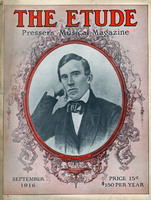Q. I see some pianists play with the wrist held very low and others with the wrist held high. What is the concensus of opinion among the best teachers upon this. I hear good results produced by both methods. Every teacher I have asked for an opinion seems to straddle the question.
A. You are quite right in saying that good results are produced by either method, but if your observing of the pianists you heard had been close enough you could have noticed that none of them played everything with the same wrist position. Certain key combinations are as impossible with a low wrist as certain others are with a high wrist. The chord F sharp, D, A, F sharp, for instance, is impossible to strike with a low wrist, while the chord of G major in either of its three positions is easier to play with a low wrist. My advice is therefore: do not pin your faith on either “method” but work for “results” and observe the positions by which you obtain the best results. The question in all three matters is not whether the wrist is high or low, but whether it is “limp,” loose, responsive. It is generally accepted that the forearm from the elbow pit to the finger roots (including the wrist) should form a straight, horizontal line, from which the wrist may depart upward or downward as scale and arpeggio passages or chords may require.—Constantin von Sternberg.
Q. Where was the composition “In the Morning” of Grieg’s “Peer Gynt” Suite adapted in Ibsen’s “Peer Gynt”? I cannot find a suitable place for this piece.—T. K.
A. “In the Morning” in Grieg’s “Peer Gynt” Suite, is usually played immediately before the opening number,—that is, before the beginning of the poem.
Q. Where is Mozart’s tomb?—T. K.
A. Mozart’s tomb is in the cemetery at Vienna in the group of tombs which includes Beethoven, Schubert, Brahms, Johann Strauss, von Suppe, and others. Where Mozart was buried, no one knows. The day of his funeral was a day of terrific storm and the few stragglers who went to the funeral deserted the procession before it reached the grave.
Q. What is the difference between duet and obbligato?—T. K.
A. The difference between duet and obbligato is this: a duet is a piece written for two performers, both of whom are supposed to have an equal part. The obbligato is a part of more or less decorative character written to go with a composition, not as an integral or dual part, but as something to enhance the original. For instance, a great many original compositions for voice have been written to which there have been added obbligatos by other composers in later years.
Q. What is the meaning of Ossia?—J. W. H.
A. Ossia (Italian for otherwise) means an alternative passage. Such a passage is usually easier. The “ossia” is customarily printed in smaller notes.
Q. Is an interval smaller than the semitone ever used in modern music?—E. von S.
A. No. In the portamento in singing smaller intervals may be detected in sliding from one tone to another. The same can, of course, be produced where the portamento is indicated on the violin. In the celeste stops of the organ intervals smaller than a halftone are used. Our ears, however, are not trained to identify these intervals as intervals, and there is no recognized modern system of notation by which these intervals can be indicated.
Q. Who are the best known pupils of Mme. Marchesi?—W. W. W.
A. Gerster, Melba, Calve, Murska.
Q. Why is the name Arion given to many musical societies?—L. F.
A. Arion was a Greek singer, a poet and a player on the cithara who lived in the seventh century before Christ.
Q. Will you kindly give me the names and addresses of some of the leading conservatories west of the Mississippi River?—D. J.
A. The Etude cannot give information of this kind. All such inquirers are respectfully referred to the advertising pages of this and other reputable musical journals.



